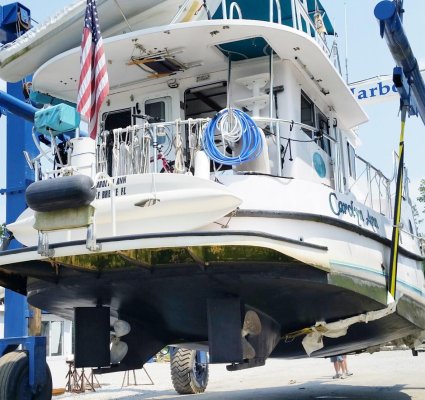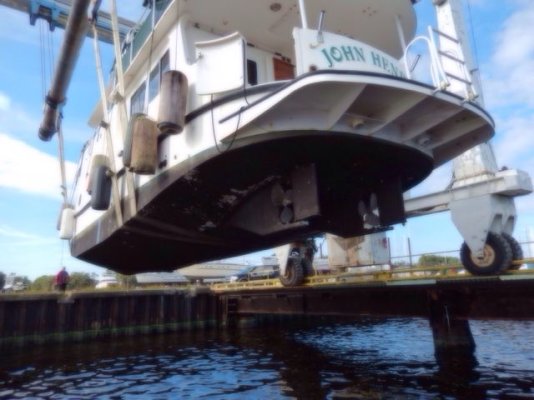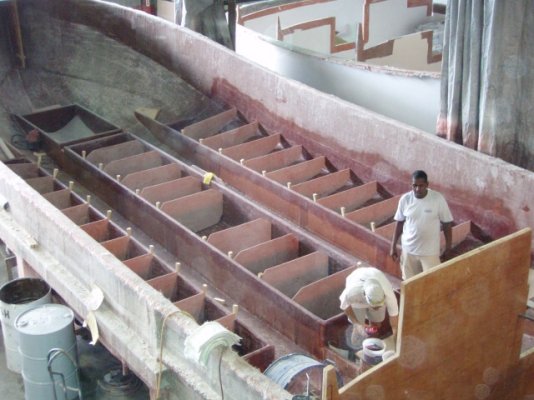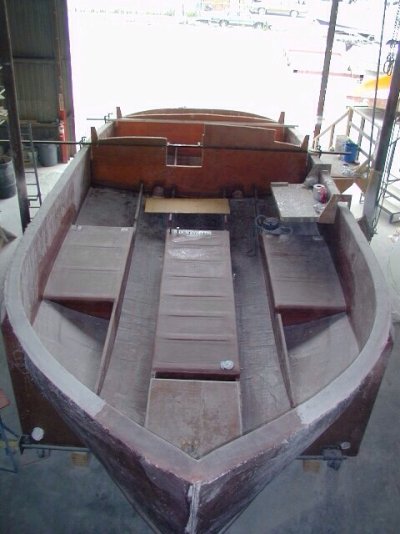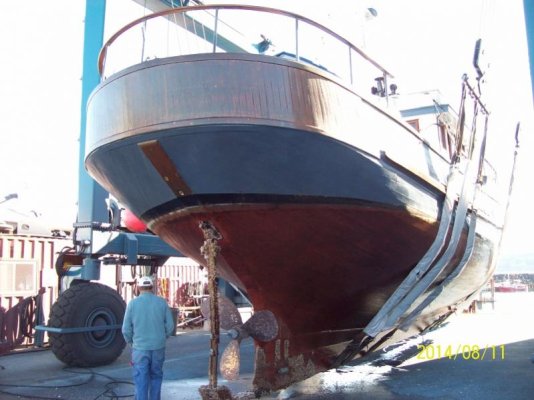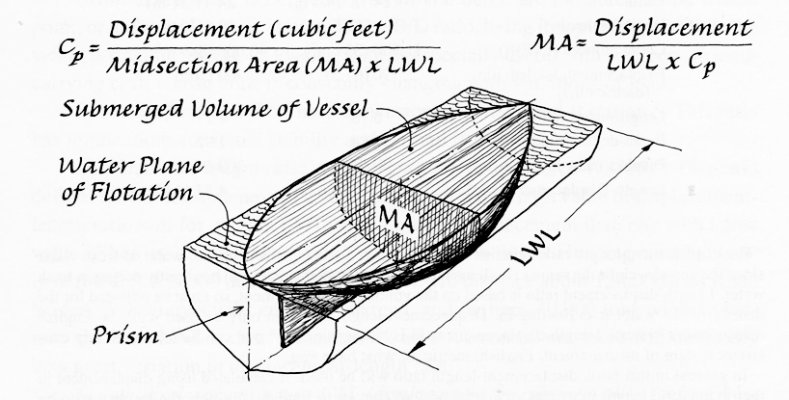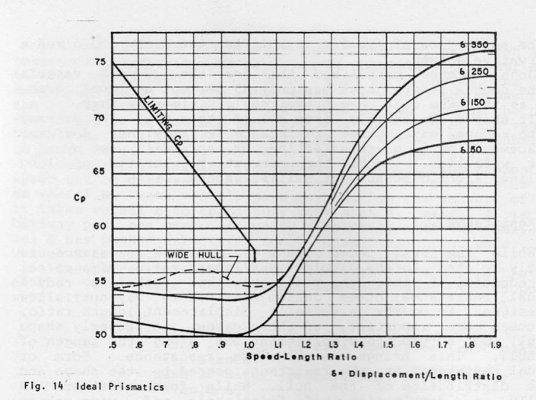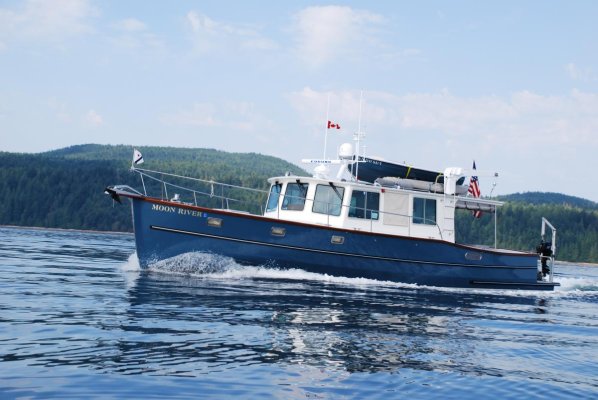Hi all, it's been awhile since on the forum. As an 2007 flybridge N-37 owner and cruiser with 40,000 miles under the keel including three great loops and most of the western Rivers this is an interesting thread that is close to my heart. We were full time live aboards for most of that time but now have a dirt home in New Bern to winter in as we've been captured by our grandchildren in Raleigh, NC.
These are my opinions and experience.
A full displacement vessel moves through the water as opposed to on top or partially ontop of the water. It generally has a full shape and weight that precludes moving it thru the water any faster then the point at which it begins to they an climb it's bow wave.
At my 7knt cruise, my N-37 is level and runs very well at 7 knots generating almost no wake (the best metric for cruising as a displacement vessel). Getting me an overall fuel burn of approximately 2.3 gals per hour including the generator and diesel heater.
These Great Harbours have offshore sea legs as evidenced by the N-37 that cruised to Hawaii from Jacksonville and one that cruised to Bermuda from Jacksonville and then to Newport RI.
The flybridge is a great party place however is not good for docking as it has a center helm with no visibility of the stern or sides of the boat. This as opposed to the lower helm which affords the best visibility.
The flybridge radar arch and bimini increases air draft so must be dropped/lowered to clear some fixed bridges e.g. Western Erie Canal (15'), Champlain Canal and Chicago River 17'. The non fly bridge N-37s can just drop the mast however dropping the radar arch can be problematic if not engineered to drop. I always preferred a flybridge, however as I've aged I haven't used the upper helm underway nearly as much because of Dermo issues and becoming more in love with comfort, anti bugs, cold, heat, etc

.
Plenty of area for solar on either model.
Love the engine room, bosun locker shallow draft, big tankages, eases of handling, walk around decks, real redundancy of second motor and sea kindly handling nature.
This boat handles sea extremely well for it's size. Lou Codega the NA/Naval PE WEBB graduate MIT naval engineer masters graduate inked this "form stable" hull configuration and can explain it better than I. I only know it works. We have a former Krogen and Fleming owner who now owns an N-47 and will gladly state how his N-47 handles sea state better than the many other boats he has owned and doesn't require the complex potentially maintenace intensive active stabilizers. If ever in a mooring/anchorage area with many other boats and a wake comes through watch the various boats motions as to the degree they roll and how long(many oscillations) it takes for them to settle. We generally experience only one roll period before settling
In my N-37 cruising we have been in some real poor conditions (my stupidity) the boat did better than us.
The rounded and upturned stern provides great following sea handing as seas seem to just ride under the boat without broaching. That said, I want no part of any breaking seas as sometimes occur at the bar entrance to inlets. Those are dangerous for any boat unless surf rated.
The worst most uncomfortable sea state I been in was in Lake Michigan when for 8 hours we had extremely steep 6' cresting and breaking seas with occasional 8 ftr's from 3 simultaneous directions such that there was no heading that could moderate the seas. This resulted in a crazy violent corkscrew motion rolling to our maximum of 21 degrees port and starboard while pitching 11 degrees fore and aft. It was a hang on until into a refuge harbor. The boat handled it fine, nothing broken except my pride and almost my marriage. This was my fault a real stupid by me for thinking "it doesn't look that bad let's go"!!! That statement says it all. Bad doesn't belong in any sea state assessment.
Lou has told me these boats are potentially self righting given the low center of gravity with the positive buoyancy afforded by all the above rub rail, nida core, dyvinycel coring. this also make these boat unsinkable and this is not conjecture as there was one GH-37 burned to the waterline still floating after the fire was put out with flooding it then towed to a ramp for forensics as it became a homicide crime scene. These Great Harbour's are very stiff (resistant to rolling) with the hard chines and have a very low center of gravity. They behave similar to a catamaran (considering the 16' beam in a 37' waterline) however without the snap roll some cats exhibited in sharp steep beam seas nor any sensitivity to weight (laddening) and bridge web deck slap.
Note that all the Great Harbour trawler share the same exact hull design below the rub rail and configuration just that the 47' models have a 10' section added in the center. The greater windage of the GH pilot house models make them more difficult to handle in high winds and awkward to negoitate some types of locks, docks or picking up a mooring than the N's with the 360 degree walk around decks and visibility, however this doesn't stop the GH Pilothouse owners from cruising all areas. The GH pilot house model owners just adjust. There is no other boat that I'm aware of that offers the amount of stability, living accommodations, storage, tank capacities, equipment and systems access and cruising ability in this footprint.
Lou created this design drawing from commercial work boat hulls especially fishing boats requiring stable work platforms and large volumes in the hull for catch etc.. It is interest to me how similar our bottom is to that of the commercial tows which also have hard chines and upturned sterns with keel protected props.

